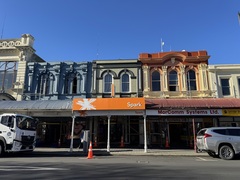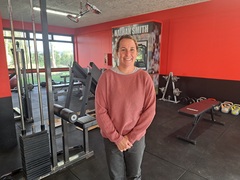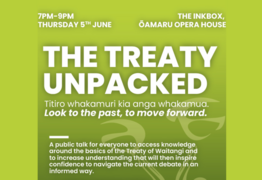Ageing and dementia top of mind for Village Architect
Ashley Smyth
03 June 2025, 10:41 PM
 Sara and Patrick McCunnie ready for Steampunk weekend at The Village Architect on Tees Street last week. Photo: Ashley Smyth
Sara and Patrick McCunnie ready for Steampunk weekend at The Village Architect on Tees Street last week. Photo: Ashley SmythSara McCunnie is the new face on the Tees Street block, with her business The Village Architect, but hers will be a familiar face to many in the Waitaki.
Sara and her husband Patrick live in Livingstone and have been heavily involved in the Duntroon community over the years.
The couple have lived in the area on and off, since their children were little.
“We moved to Australia so that I could study architecture, and we stayed there with our kids. They left home and we came back here as empty nesters.”
Sara was “really lucky” to get a job with resthome operator Ryman Healthcare.
“I just had a tremendous career there,” she says.
In the 13 years she worked for Ryman, she was involved in master planning and designing major refurbishments of rest homes. She was initially based at their Christchurch head office, then after four years, worked remotely from Livingstone.
When her job with Ryman ended in April, Sara decided to “pivot to self-employment”.
Working remotely had already allowed her to take on smaller projects on the side.
“Just doing little bits and pieces.
“I did our own home renovation, some work for my sister and other various locals, just to keep my hand in it.”
The scale of the work Sara was doing at Ryman was “massive”, so she enjoyed the smaller, practical “still lodging a building consent-type of hands-on stuff”, and it made the transition out of Ryman “reasonably smooth”.
She is excited about her new premises in town at 16A Tees Street, and having a presence in town, after feeling a bit invisible at home.
She wanted to be in an old building, and says she chose hers due to its level entry, lighting, and “nice vibe”.
“I’m just really lucky I found it.”
Heritage buildings, and making them more liveable for people as they age, holds particular interest for Sara.
“ I have always lived in old homes and I just love them. You know, I've chosen an old shop because I love it. I think the Waitaki District, the built heritage here is just amazing.
“The reality, too, is that it's the homes that people own here . . . I had a look at the stats at the council for their new dwelling consents in the last quarter of last year and it was 17, you know.
“We don't build a lot of new stuff here, and so there's probably work for refurbishment. And if I can bring an ageing-in-place kind of lens on that for people, that's great as well. If you can set up your home so that you can grow old in it.”
Sara enjoys the complexity of adapting older buildings.
“I’ve just got a bit of a passion for old things. I'm an old-fashioned kind of girl, you know. I make jam, and I sew my own clothes, and I just like old-fashioned things, I suppose.”
However, she also uses the latest, top-of-the-line software and products and says her work is all about utilising the best of both worlds.
Specialising in work for people with dementia
During her time with Ryman, Sara developed a particular passion for designing spaces for people living with dementia, which led her to pursue a doctorate on the topic.
“Dementia is so much more than memory loss,” she says.
“It affects your eyesight, affects your hearing, it affects your ability to manage stimulation … there's kind of overlaps with a stroke and with autism, you know, some of those kinds of things. It is really easy to get overstimulated and really easy to get under-stimulated as well.”
There are a lot of different models internationally for how people can live with dementia and Sara visited the Netherlands in 2022 for her study.
“They're quite innovative in what they do. In New Zealand, there's a more institutional model that we’re moving away from slowly.”
Sara is interested in how she can help local people adapt their own homes for ageing or dementia, but is also open and keen to consult with key operators and other architects nationally.
“There is a lot of social stigma towards people with dementia, and there will be a move towards unlocking doors. It's a bit of a human rights issue,” she says.
There is a need to strike a balance between safety and positive risk-taking, which is something New Zealand is currently adjusting to.
“Some of the places I saw in the Netherlands were amazing - people cooking, people gardening, people working with animals, and in New Zealand you can end up living in a bit of a hotel here and there's a whole lot of issues with that, with boredom and lack of sense of place.”
The number of people with dementia is on the rise, and Sara estimates there are around 520 people in the Waitaki District who have symptoms of dementia, many of whom will be undiagnosed.
“I think one of the things, too, is . . . it's sort of treated a bit like a switch that's flicked, you know, and then you're in care and you're locked up and that's it, and you can't remember anything anymore. And it's not really like that.”
There are many different types of dementia, and people have their individual journeys through the symptoms, she says.
One person’s symptoms might be in reverse order from somebody else’s, depending on which part of the brain deteriorates first.
All aged-care homes and retirement villages should be dementia-friendly, Sara says.
“Because the more enabling the environment is, the more autonomy and independence that person has and the longer they can live a full life.”
With her expertise in care home refurbishments, she can provide services to places that are already functioning.
To help people diagnosed remain in their homes longer, there are also certain things she can advise them on.
“There are small things you can do, like swapping out your cupboard doors so they've got glazing in them so you can see this is the cupboard the cups live in, you know?
“You've got your coffee and tea tins - mine are the same size, one's blue and one's yellow, you know, really, they probably need a label on them. A lot of it's really commonsense stuff.”
Tonal contrast is also important to take into consideration, she says.
Floor transitions between carpet and vinyl need to be the same tone, because a person’s depth perception is altered, and they can mistake a change in colour for a step.
“I've got a black doormat, that's a no-no because that might just look like a hole in the floor.”
“So these might be people who are quite capable of engaging you in a full conversation, they'll know who their grandchildren are, and what they did for a job, it'll just be that their visual processing is really damaged.”
Sara is in the process of collaborating with Auckland University and Alzheimer's New Zealand to develop training around dementia design principles for detached dwellings in New Zealand.
Helping people with regulations around sleepouts and granny flats and where to put them is also in her wheelhouse, and “checklist assessments” about what can and can’t be changed, and what a project might entail.
“Then we could embark on a renovation project, if people want to go down that line. Or it might be enough to say ‘this place isn't suitable, it's time to go’.”
Sara is open by appointment, but aims to be at The Village Architect on 16A Tees Street five days a week.
NEWS






